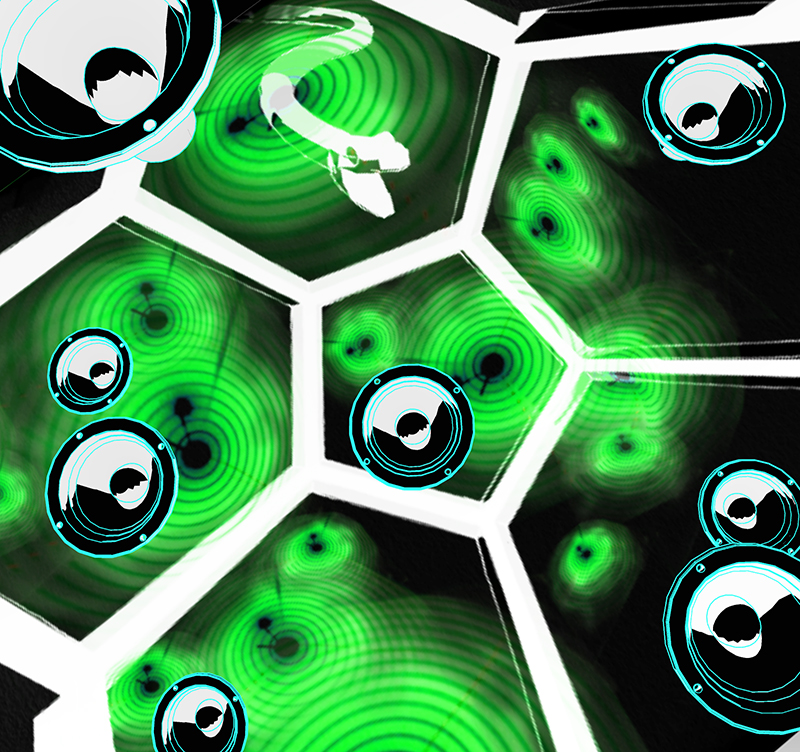Explore the Objects
Sound Art
Sound art is concerned with challenging how sound has been traditionally organized into music and performed in the concert hall. Sound artists, for instance, often undermine assumptions about the distinction between music and noise, utilizing the full range of available sounds in their practice. The sounds in their artwork may be recorded or they may be created (electronic sounds), and the computer allows the full integration and manipulation of recorded and created sounds. Sound art can be sculptural in form, emanating from a particular object, or it can be architectural or environmental, exploring the relationship between sound and space.
Ryo Ikeshiro
Pika! Ppeonjjeog, Pika! Ppeonjjeog / Ppiikkaa!! PPppeeoonnjjjjeeoogg, 2015-16
Immsersive audiovisual installation with 3D-engraving and printing
Created by a recursive algorithm, the objects and projections depict a speculative environment. A self-similar structure is also found in the audio – the Risset rhythm, an aural illusion equivalent to Escher’s Stairs. “Pika!” and “ppeonjjeog” are examples of “sound symbolism”, depicting flashing light in Japanese and Korean. They are sung by Hatsune Miku, a virtual idol.
PerMagnus Lindborg with Alvaro Cassinelli
Loki's Pain, 2020
sonification-visualisation of seismological geodata; aluminium, steel, vinyl, paper, bowl speakers, subwoofer, amplifiers, media playback, laser projectors, digital interfaces
Loki's Pain is an immersive audio-visual installation. Visitors take the place of Viking god Loki, who is chained underground and tormented with dripping venom; his painful writhing is the cause of earthquakes. Loki's Pain follows Pacific Belltower (Lindborg 2017), which does live sonification of Internet seismological data.
We thank SCM student Abby Yuen Hui Ching and Technical Officer Tung Wing Hong for their invaluable contributions.
We thank SCM student Abby Yuen Hui Ching and Technical Officer Tung Wing Hong for their invaluable contributions.
Samson Young
Possible Music #2 , 2019
LED lighting system, 16-channel sound installation; sound, 60 min loop
This work is a collaboration between the artist and the University of Edinburgh’s Next Generation Sound Synthesis (NESS) group, who developed software that models the sound of musical instruments. For historians this offers the opportunity to hear lost objects. The artist however is interested in the 'impossible.' For instance, how would a bugle sound if it was activated by a 300 degrees Celsius breath?
Ryo Ikeshiro
Pika! Ppeonjjeog, Pika! Ppeonjjeog / Ppiikkaa!! PPppeeoonnjjjjeeoogg, 2015-16
Immsersive audiovisual installation with 3D-engraving and printing
Created by a recursive algorithm, the objects and projections depict a speculative environment. A self-similar structure is also found in the audio – the Risset rhythm, an aural illusion equivalent to Escher’s Stairs. “Pika!” and “ppeonjjeog” are examples of “sound symbolism”, depicting flashing light in Japanese and Korean. They are sung by Hatsune Miku, a virtual idol.
X
<
>
PerMagnus Lindborg with Alvaro Cassinelli
Loki's Pain, 2020
sonification-visualisation of seismological geodata; aluminium, steel, vinyl, paper, bowl speakers, subwoofer, amplifiers, media playback, laser projectors, digital interfaces
Loki's Pain is an immersive audio-visual installation. Visitors take the place of Viking god Loki, who is chained underground and tormented with dripping venom; his painful writhing is the cause of earthquakes. Loki's Pain follows Pacific Belltower (Lindborg 2017), which does live sonification of Internet seismological data.
We thank SCM student Abby Yuen Hui Ching and Technical Officer Tung Wing Hong for their invaluable contributions.
We thank SCM student Abby Yuen Hui Ching and Technical Officer Tung Wing Hong for their invaluable contributions.
X
<
>
Samson Young
Possible Music #2 , 2019
LED lighting system, 16-channel sound installation; sound, 60 min loop
This work is a collaboration between the artist and the University of Edinburgh’s Next Generation Sound Synthesis (NESS) group, who developed software that models the sound of musical instruments. For historians this offers the opportunity to hear lost objects. The artist however is interested in the 'impossible.' For instance, how would a bugle sound if it was activated by a 300 degrees Celsius breath?
X
<
>






